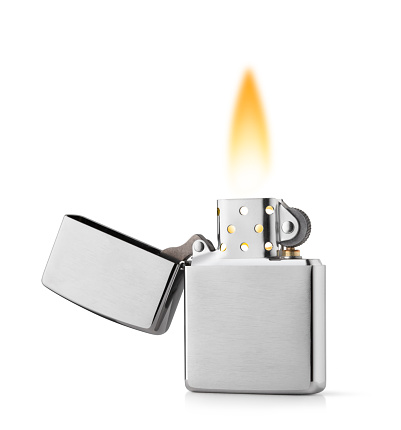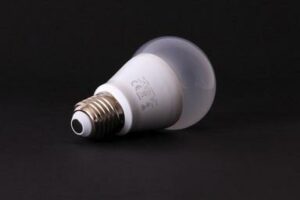In this article, we will talk about example of kinetic energy to light energy conversion.
- Scratching two stones with each other
- Stove
- Lighter
- Scratching match stick on match box
- Lighting bulb
- Sunlight
- Crackers
- Torch
- Display
- Wireless charging
- Tuning forks
- TV remotes
Scratching two stones with each other
If two rocks are hit with one other, a spark is created. All of the kinetic energy in the rocks is pushed from one to another at the instant of impact. If that spot is really small, directing all of that energy through it warms it up and causes it to become loose. A shard of granite breaks free and soars off, remaining heated.
That’s the source of the spark. It works well with particular types of rock that have a proclivity for breaking off very small shards, such as flint. Resistance, instead of impact, can be used, with the friction breaking off pieces.
Stove
A pressure stove features a pressurized chamber and a tip that delivers the vaporized gas into the burner rather than a flame. While using a pressure cooker, there are two factors you should perform. The first step is to pressurize the tank with gas, and the next is to generate sufficient heat to spark the vapor.
Kerosene isn’t as combustible as other petroleum distillates like gasoline or propane, and you can’t light it with a match. As a result, a pressure stove includes a tiny tray in the flame into which distilled alcohol, which is much more combustible, is poured.
You fire the alcohol to warm the burner, then pressurize the tank by pumping it, which vaporizes the kerosene and drives it through the gate and into the stove, where it burns.
A pressurized stove’s fire, and consequently the stove’s heat, may be adjusted in two ways. The control knob, which controls the opening size and volume of gas emitted, may be adjusted. You may also boost the gas pressure by pumping the tank.
Lighter
The piezoelectric effect is used to power the gas lighter (conversion of mechanical stress into electric signal). A piezo-electric stone is inserted within the gas lighter, at one side of the spring, another end of which is attached to a hooked hammer inside the oblong lighter.
Scratching match stick on match box
To make it particularly harsh, this band on the box includes a little crushed glass. Resistance is created by rubbing the abrasive match head across the abrasive band. This generates just sufficient heat to initiate a chain reaction.
Lighting bulb
The conversion of kinetic energy to light energy is fairly simple. Once you power on the breaker in a DC connection, a movement of electrons, i.e. a large number of electrons, begins to flow from the negative end to the positive end. A filament in a bulb provides impedance to this flow, causing the ions to slow down. This produces heat, and when the temperature rises over a certain point, the filament begins to emit light.
The movement of electrons (traveling electrons have kinetic energy and can-do work) was created by the voltage differential between the ends, and the opposition to this flow produced heat and light. It seems it’s the same with an AC circuit as well.
Sunlight
There will be a large number of helium and hydrogen atoms on the sun. The nuclear fusion of hydrogen nuclei into helium in the sun generates energy (heat and light). A fast (kinetic energy) hydrogen clashes (resistance/friction) with helium, emitting warmth and brightness as a result.
Crackers
A Christmas cracker is a cardboard sheet tubes that has been wrapped in colorful sheets and tied on both ends. Within the cracker is a bouncer, two pieces of chem6ically coated paper that respond with friction and cause the cracker to bang when ripped apart by individuals.
Torch
Whenever a flashlight’s button is turned on, it makes a connection among two touch sheets, which starts a flow of energy supplied by the battery. The cells are linked in such a manner that energy (the movement of electrons) flows between the battery’s positive and negative electrodes.
Display
The liquid crystal substance of a liquid crystal display (LCD) is sandwiched above two layers of glass. Liquid crystal particles are oriented in alignment with the glass plate in the absence of any voltage supplied between clear electrodes. When a voltage is applied, they reverse its orientation and become upright to the glass surface. Based on their alignment, they have different optical properties.
Wireless charging
Wireless chargers generate a magnetic field that your phone, watch, or another gadget absorbs in order to gather energy. When you set a gadget on a wireless charging pad, a tiny coil in the device absorbs and collects magnetic field energy, which it then utilizes to charge the battery.
Tuning forks
A steady electrical circuit stimulates the tuning fork, allowing it to dynamically move. When the fork’s prongs make contact with something of significant mass, the fork’s resonance frequency lowers. This frequency shift is detected by the circuit, which signals the existence of mass touching the fork.
TV remotes
TV remote controls operate in a similar manner, except they use a different form of light known as infrared (or IR for short). The remote control has an LED light that flashes very fast to broadcast a message that is picked up by the TV. The remote is referred to as the transmitter, while the television is referred to as the receiver.
Frequently asked questions |FAQs
Ques. What is the relationship between kinetic energy and light?
Ans. Kinetic Energy – This is the energy that light has as a result of its mobility. As photons have no mass, their kinetic power matches their total energy. As per Relativity Theory, the energy of light permits it to form a gravitational field.
Ques. What is an illustration of light kinetic energy?
Ans. Radiant energy also called light force or electrical radiation, is a sort of kinetic power that flows in waves. Examples include solar power, x-rays, and radiofrequency.
Also Read:
- Elastic potential energy examples
- Example of mechanical to sound energy
- Light energy examples
- Does mass affect potential energy
- What does not affect potential energy
- Example of kinetic to sound energy
- Example of chemical to mechanical energy
- Examples of potential energy in your home
- Chemical energy to light energy
- Example of gravitational energy to mechanical energy
I am Sakshi Sharma, I have completed my post-graduation in applied physics. I like to explore in different areas and article writing is one of them. In my articles, I try to present physics in most understanding manner for the readers.


